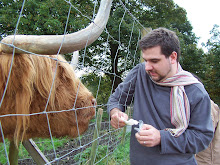It was going to be the smartest allotment in the country and win awards for its beautifully crafted raised beds and furniture. People would come from far and wide to marvel at it's ingenuity, and it would be featured on Gardeners World. I had already planned out the whole plot, and had been down to B+Q to price up all the timber I would need to built the beds and so forth. I reckoned on £300 or so for the beds this year, and a similar amount next year. Sounded reasonable.
But then something happened to make me change my mind.
The more I talked to the other allotmenters, the more I began to wonder if the route I was taking was the right one. They made comments about 'not being what allotments are about' or 'not being in the spirit of it'. This made me wonder about something I had not really considered before. What is allotmenteering about? I had assumed it was about getting out in the fresh air, and growing your own veg. Is there more to it than this?
The other plots down my allotment are a real mix bag; Some are ancient, tended by equally ancient and unbelievably wise owners. They tend to scoff on modern conveniences like raised beds, instead favoring lovingly tended beds of healthy looking plants and hours of painstaking, back-breaking hard work; Some are from the Bob Flowerdew school of thought, and are a scruffy mix of reclaimed old tyres and carpets, organically grown spotty veg and wind-blown weeds growing 'where nature intended'; Other allotments have neatly made raised beds, fashioned from plywood or treated timbers. It was this last group that I initially felt drawn towards, and it was this I had in mind when I designed our family allotment.
So what changed my mind? It wasn't the cost, well not entirely. There was a time I could have spent £300 on our garden without even thinking about it. Things are a bit tighter nowadays, but I could still stretch to it if I thought it was important. No, what really made me stop and think was the comments of my peers down at the allotment. They often looked on disparagingly at the freshly sawn timbers of the other new starters - the ones that I thought looked great- commenting on how much timber they had used, and how much it must have cost them and what a waste it was. The first time I heard such comments I thought it was sour grapes, or a 'it wasn't like that in my day' sort of attitude, but the more I heard it, the more I began to think: No one ever said anything bad about the scruffy organic Flowerdew plots. May be there was something in it.
I realised I was guilty of a basic blunder. I had been designing our allotment the same way I would have designed a garden. But it's not a garden. It is an allotment, and what is important for an allotment is not the way it looks, or how many awards it gets. What is important for allotments- the very spirit my fellow allotmenters had talked about- was that we should get out of them what we put into them, with interest applied by mother nature herself. Pristine timbers may look nice, but they wont increase my yield come harvest time, and every time I look at them I would be reminded that I had taken the easy route and just bought timber from B+Q. That's not low impact. That isn't environmentally friendly. And it isn't 'what allotments are all about'.
And so, with this see change in my thinking in effect I have decided that we will only use recycled, reclaimed, or reconditioned things on our allotment as much as possible. I might stop short of the Flowerdew-esque piles of old tires and rotting carpet, but I won't be buying any brand new timbers for our raised bed. If it's not the smartest plot on the site it doesn't matter, so long as we are happy with it.

The compost bin, which, as you can see, is constructed from reclaimed timber and old packing crates. Not smart perhaps, but I had great fun making it. I just need more packing crates to make a companion for it, and some scaffolding planks for our raised beds. I need to keep my eyes peeled.





